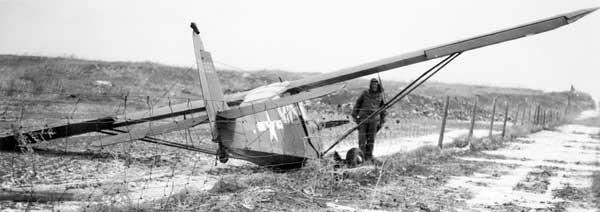
Aeronca-Grasshopper - $$4.95
The Aeronca Model 7 Champion was a two-seat high-wing cabin monoplane, used by the military as a liaison/artillery spotter aircraft, and in general aviation. Immediately after World War II, the US Lightplane market experienced a boom and Aeronca's Champion proved extremely successful.
Aeronca L-16 Grasshopper Light Military Observation Airplane
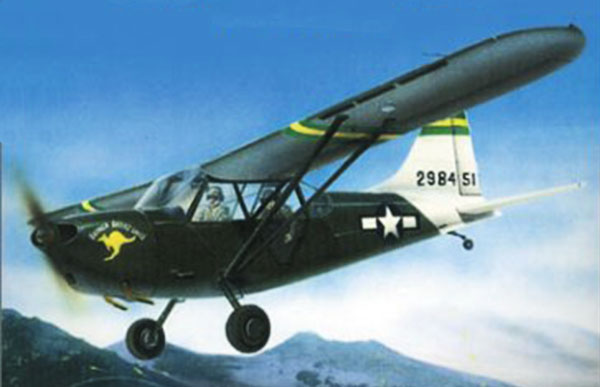
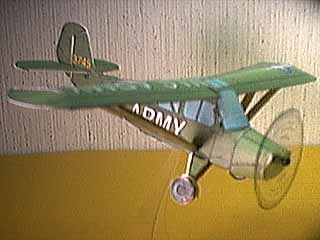 After WWII the government asked for designs of light observation
aircraft and this was the Aeronca effort. It's interesting to see
how close the private and military designs are to each other with
he exception of larger engines and more glass around the cockpit.
After WWII the government asked for designs of light observation
aircraft and this was the Aeronca effort. It's interesting to see
how close the private and military designs are to each other with
he exception of larger engines and more glass around the cockpit.The post-war L-16 is an Aeronca Champ, period. Just picture it as an 85 or 90 hp Champ and you've got the entire picture. Also, it's seldom you find an L-16 that hasn't had its greenhouse Plexiglas replaced with standard Champ windows. Anything that you can say about a 7EC Champ can be said about the L-16, except the L-16 is an honest war bird, even though they never actually saw any combat...
Aeronca Grasshopper
The post-war L-16 is an Aeronca Champ, period. Just picture it as an 85 or 90 hp Champ and you've got the entire picture. Also, it's seldom you find an L-16 that hasn't had its greenhouse plexiglas replaced with standard Champ windows. Anything that you can say about a 7EC Champ can be said about the L-16, except the L-16 is an honest war bird, even though they never actually saw any combat.
The 1940's were a time of great evolution for the Liaison aircraft used by the military. The U.S. Army found the large, powerful L-1 and others like it to he too cumbersome to be useful in many of the theater of operations, particularly if the war became mobile. Armor was being used in new and effective ways, and to support that firepower, the small, nimble light planes proved their worth by directing allied artillery upon enemy positions with such accuracy that German gunners learned to keep their positions quiet when an L-4 was in the area, lest the L-bird call in an artillery strike.
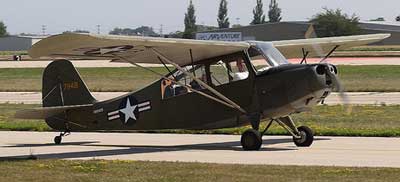 The lightplane evolved during the Second World War, growing
a bit in weight and capability, but still maintaining the Short
Takeoff Or Landing (STOL) capability and ease of field level maintenance
that made the lightplane work so well as a liaison workhorse.
The Stinson L-5, with higher horsepower than the L-4 and good
low-speed handling, proved to be a great machine for many who
piloted them over the steamy jungles of the New Guinea campaign
in the Pacific.
The lightplane evolved during the Second World War, growing
a bit in weight and capability, but still maintaining the Short
Takeoff Or Landing (STOL) capability and ease of field level maintenance
that made the lightplane work so well as a liaison workhorse.
The Stinson L-5, with higher horsepower than the L-4 and good
low-speed handling, proved to be a great machine for many who
piloted them over the steamy jungles of the New Guinea campaign
in the Pacific.
Early in 1947, the Army Air Force gave a contract to Aeronca, Inc. of Middletown, OH for 509 copies of a military version of their popular two-place trainer, the "Champ." Designated as the L-16A, the airplane differed little from civilian airplane. An expanded area of Plexiglas was added to the aft windows, and the entire cabin roof was also glazed. The engine was also a bit different, with a fuel injected 85 hp Continental 0-190-I installed in the nose.
The cabin door also had an additional feature - a quick release lever to pull the hinge pins and jettison the door. The interior, thankfully, did not feature the flocking used on the side panels of the original, just paint, thank you, and other interior appointments used on the civilian version were also deleted. Thanks to the fuel-injection system, the carb heat knob was also missing from the cockpit - there is no carb heat. On the instrument panel, the only change needed was the substitution of a sensitive altimeter instead of the standard non-sensitive unit sold with the civilian airplane.
While production of the L-16A was underway, the creation of the U.S. Air Force on September 18, 1947 meant that the last deliveries of L-16A's went to the USAF. An additional order for 215 L-l6Bs was awarded in 1948. The major difference in the airplanes was the increased power in the engine compartment - the C-85-8 (0-190-1) was pushed up to 90 hp in the C-90-8 (0-205-1) version. Basically the same engine with a slightly higher compression ratio accounting for the extra ponies, it still did not have the added weight of a starter, generator and associated electrical shyster. With the added horsepower came a need for a bit more directional stability, so an extended dorsal fin was added to the vertical stabilizer.
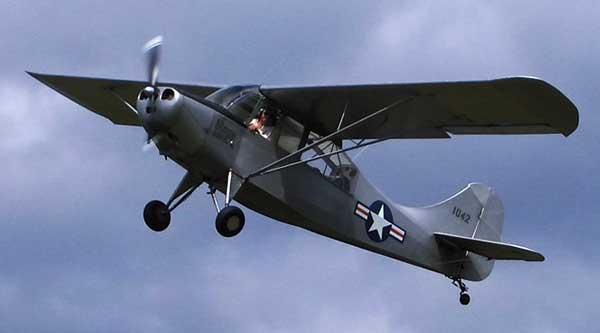
To provide a longer range for the slightly more thirsty 90 hp engine, an extra fuel tank was added to the right wing. Another change made to the airplane was the change of the landing gear to the new Aeronca "Low-Bounce" gear. Designed to allow a higher rate of sink and less rebound in the event of a "stronger than normal" contact with the ground during landing, the new gear was a bit longer and used an extended stroke along with a rubber "bumper" at the bottom of the oleo strut. Champs and L-16s equipped with this gear are easy to spot, due to their exaggerated "knock kneed" appearance.
After NW II, the mission of the liaison pilot within the U.S. Army Air Force continued to evolve. The L-16's mission in that arena was a bit cloudy.
Before the L-16 went into production, many airplanes destined for combat duty
as Liaison aircraft were equipped with electrical systems to power
the radios need to maintain contact with the artillery. Since
the L-16 did not come with an engine-driven generator, the airplanes
utility in a combat situation was somewhat limited, although a
number of L-16's flew in combat during the Korean war. In Korea,
a battery powered FM two-channel transceiver was mounted in the
airplane, allowing contact with ground troops. The airplane was
not used for regular FAG duties, since the radio did not allow
direct contact on 126.18 with the artillery. Antique/Classic Director
Buck Hilbert flew L-16's in Korea and recalled that the airplanes
were often used for scouting routes for tanks and armor. The L-16,
L-5 and a few L-4's were all replaced by the L-19 (0-1) Bird dog
during the war, and eventually were turned over to the Japanese
after being rebuilt.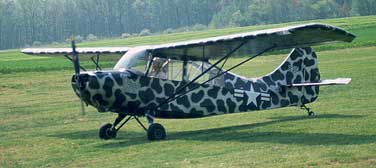
The US Army Air Corps had been slow to appreciate the value of light aircraft for employment in an observation/liaison role, but information received from Europe in late 1940. where World War II was already more than a year old, highlighted their usefulness. Consequently, in 1941 the US Army began its own evaluation of this category of aircraft, obtaining four commercial lightplanes from each of three established manufacturers, namely Aeronca, Piper and Taylorcraft. For full field evaluation larger numbers of these aircraft were ordered shortly afterwards, to be deployed in the US Army's annual maneuvers which were to be held later in the year. It took very little time for the service to appreciate that these lightweight airplanes had a great deal to offer, both for rapid communications and in support of armed forces in the field.
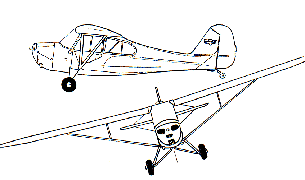
The name Aeronca Aircraft Corporation had been adopted in 1941 by the company established in late 1928 as the Aeronautical Corporation of America. One of its most successful products was the Model 85 high-wing monoplane. developed to meet commercial requirements for a reliable dual-control tandem two-seat trainer. The four of these aircraft supplied initially to the USAAC became designated VO-BO, and these were followed by 50 0-58, 20 O-58A and 335 0-588 aircraft, serving with the USAAF established on 20 June 1941.
In the following year the 0 (Observation) designation was changed to L (Liaison), and the 0-68, 0-58A and 0-588 designations became respectively L-3. L-3A and L-3B. An additional 540 aircraft were delivered as L-3Bs and 490 L-3Cs were manufactured before production ended in 1944. The designations L-30/-3E1-3F1-361-3H1-3J were applied to civil Model 65s with varying power plant installations which were pressed into military service when the United States became involved in World War II.
Most L-3s were generally similar, with small changes in equipment
representing the variation from one to another. All shared the
welded steel-tube fuselage! tail unit with fabric covering, and
wings with spruce spars, light alloy ribs and metal frame ailerons,
all fabric-covered. Land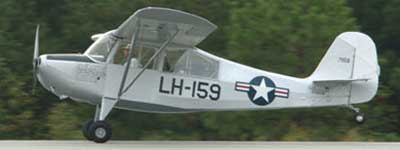 ing gear was of the non-retractable tail wheels
type, with the main units divided and incorporating oleo-spring
shock-absorbers in the side vees.
ing gear was of the non-retractable tail wheels
type, with the main units divided and incorporating oleo-spring
shock-absorbers in the side vees.
With the requirement for a trainer suitable for glider pilots, Aeronca developed an un powered version of the Model 65. This retained the wings, tail unit and aft fuselage of the L-3, but introduced a new front fuselage providing a third seat forward for an instructor, the original tandem seats being used by two pupils~ all three occupants had similar flying controls and instruments. A total of 250 of these training gliders was supplied to the USAAF under the designation TG-5, and three supplied to the US Naw for evaluation were identified as LNR. Production of Aeronca liaison aircraft continued after the war, with planes supplied to the USAF under the designation L-16.
The use of light aircraft for observation and liaison duties by the U.S. Army was a new departure in 1941. In that year, the Army obtained four examples each of the contemporary Aeronca, Piper and Taylorcraft commercial high-wing lightplanes, and ordered larger quantities of each for field evaluation in the 1941 maneuver.
The first Aeronca aircraft obtained by the Army in 1941 were four examples of the Model 65TC Defender, a light training monoplane in production for club and private use, with tandem seating and dual controls. They were designated YO-58 in the Air Corps observation category, and were powered by 65 h.p. Continental YO-170-3 engines. Substantially the same were the fifty O-58s. The twenty O-58As had a four-inch wider fuselage and the design was then fully modified for Army duties, with increased window area in the cabin for improved visibility. This version~ was designated 0-58B, with a gross weight of 1,850 lb. compared with the 1,200 lb. of the original Defender.
After 335 O-S8Bs had been delivered, the aircraft was re-classified (in common with the Piper and Taylorcraft types) in the Liaison category. The YO-58 and 0-58 became the L-3; the twenty O-58As became L-3A and the O-58B became the L-3B, under which designation production continued until a total of 875 of this model had been built. They were followed by 490 L-3Cs in which the radio was revised and the gross weight reduced to 1,800 lb. This concluded production of the L-3 for the Army. In common with many other commercial aircraft, a number of privately owned Aeronca's were commandeered for military use in 1942 after the U.S. entered the War.
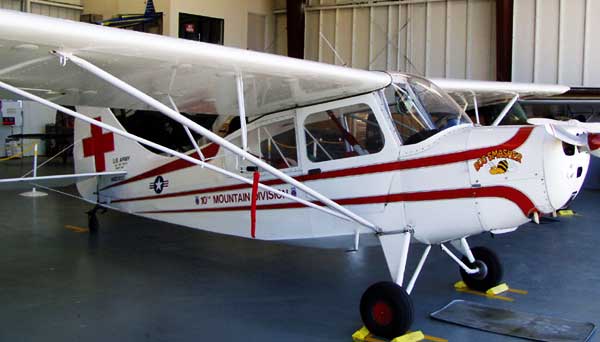
L-3 AERONCA
The L-3 was originally designated 0-58 by the military before the war, although civilians knew it as the 65TC Defender. It stands high on its tiptoes, or seems to, because its fuselage is so slab sided-a feature accentuated by the several square yards of Plexiglas the military installed.
For some reason, even when restored to military configuration, the L-3's civilian roots seem to show through more than the L-2s. Both cockpits are bare-bones Spartan in the extreme. The L-3 is far less known than any of the small L-birds, which might be because fewer of them survived the last half century. For no apparent reason, they were more likely to go derelict than any of the rest, so their wings suffered accordingly.
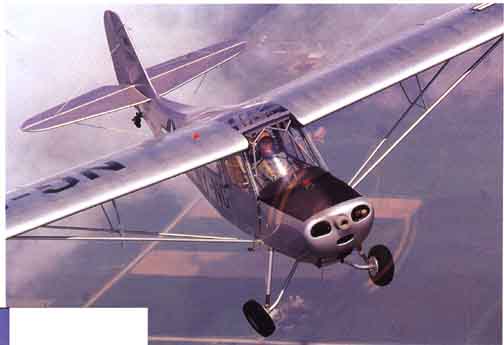
The airplane carries two people fairly well considering its 835-pound empty weight, although it's a rare one that will cruise much over 75 mph. It climbs reasonably well because of its flat, bottomed wing, but it isn't going to leap off the ground in a manner to which most modern pilots have become accustomed. Like the L-2, it's not an airplane to be flown heavily loaded on a hot day with tall trees staring down at you.
The airplanes only require basic tail wheel technique. It's not a lunch-eater and will give a solid hour of fun for five gallons of gas or less. It's also one of the less expensive of the L-birds, running in the $14,000 to $18,000 range fully restored.
L-5 (Ref)
The Stinson L-5 Sentinel has the distinction of being the only L-bird to see extensive service during World War II that was designed specifically for the job. Every other airplane of the breed was an off-the-shelf civilian hastily fitted in fatigues. The L-5 was grossly different than the rest. For one thing, it really was an aerial jeep. It was rugged as a sledge hammer, would carry anything they could get in the door and was perfectly willing to go anywhere at any time.
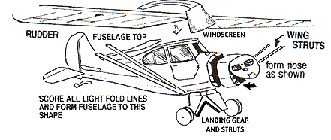 The L-5 is far from being a small airplane. It stands tall
over all the other L-birds, with the windowsill being nearly eye-level,
and climbing into the front seat actually is a climb. At 1500
pounds empty, the L-5 is nearly twice the weight of any of the
rest.
The L-5 is far from being a small airplane. It stands tall
over all the other L-birds, with the windowsill being nearly eye-level,
and climbing into the front seat actually is a climb. At 1500
pounds empty, the L-5 is nearly twice the weight of any of the
rest.
The engine is a six-cylinder Lycoming 0-435-1, putting its 190 hp out through a club-like wooden propeller, although some are equipped with variable pitched props. The way the exhaust is arranged gives the airplane a distinctive growl that very much fits its hulking appearance.
There were two basic fuselage shapes, the later ones having a huge door extending down the right side to allow carrying a casualty on a litter inside. The last version, the L-5G, also has a crank over the pilot's head that lowers the ailerons 15 degrees to act as flaps in addition to the regular flaps.
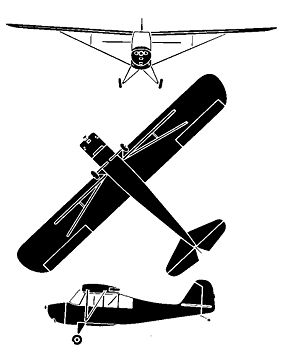 |
Crew: 2 |
